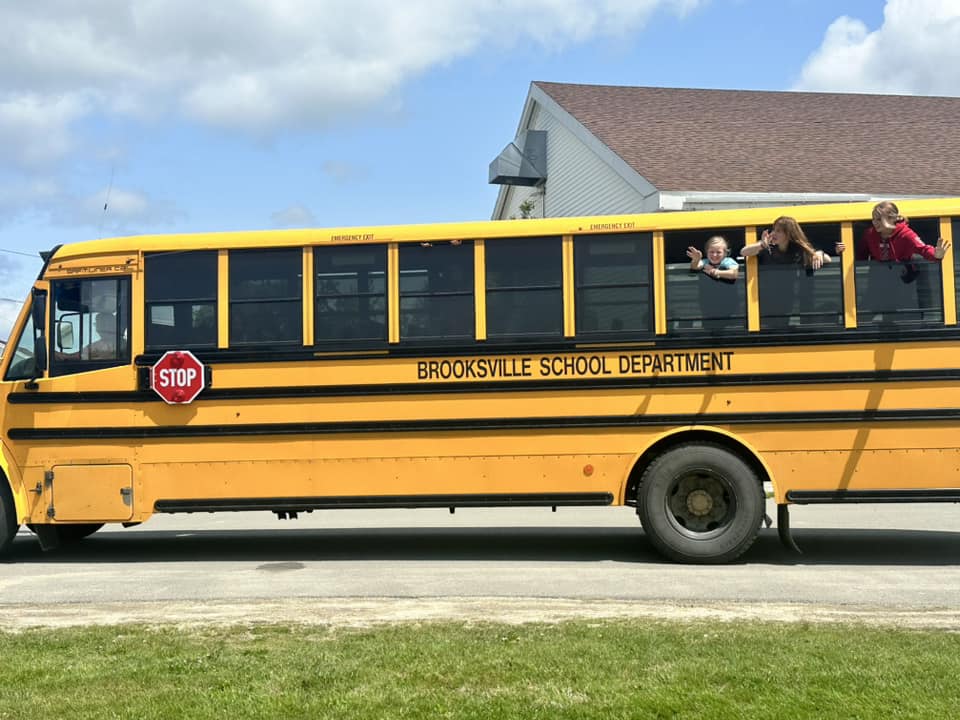Brooksville Elementary School is on a national list, along with four others schools in Maine, where enrollment declines coincide with underachievement.
(Photo via Brooksville Elementary School)
Brooksville Elementary School, a small school serving just 42 students on the Blue Hill peninsula, has faced enrollment challenges for years. Because of achievement and attendance metrics, the school has been designated by the Maine Department of Education to need the highest level of support, since its students seem to be struggling. And it’s on a national list, along with four others schools in Maine, where enrollment declines coincide with underachievement.
The report by the national education nonprofit Thomas B. Fordham Institute identified 500 underperforming, under enrolled schools across the country, suggesting that school closure may be unavoidable if district administrators fail to address these intersectional challenges of declining enrollment and poor academic performance.
“Ultimately, waiting to close a school doesn’t make pulling the Band-Aid off any less painful,” the report states. “It just means more wasted resources, less to go around, and more kids in desolate schools.”
But in Maine, where most schools that have struggling students are in remote, poor areas, the schools are considered essential service centers since students don’t have other options if they were to close, according to Dawn McLaughlin, assistant superintendent of the school union that oversees Brooksville Elementary along with five other schools.
In addition to Brooksville, the Maine schools highlighted by the report are Valley Rivers Middle School in Fort Kent, Walker Elementary School in Liberty, Dresden Elementary School and Mt. Vernon Elementary School.
“In small towns like ours, if they lose their school, they lose their sense. It’s their community, you know, and it’s their identity, and it’s used for a lot of different community events,” McLaughlin said. “It’s important to these small towns to keep their schools open. It’s a part of their history and if they close, they risk losing their identity as a community.”
Despite enrollment and achievement challenges, the school union is not considering closing Brooksville Elementary. If they do, McLaughlin said, students don’t have any other high-quality educational options to turn to.
How enrollment and achievement are tied together
Chronically low-performing schools, many of which may be grappling with systemic challenges and resource constraints, have been disproportionately affected by enrollment declines, according to the national report. These schools were more than twice as likely to experience enrollment declines exceeding 20%.
The Maine Department of Education said it has not found any evidence of this correlation in Maine.
Enrollment declines across the country have been common since the pandemic, with more than 5,100 schools losing students that they never recovered. Many of the 500 schools the report identified as both under enrolled and underperforming are also in poorer neighborhoods, the report found.
The prevalence of middle and elementary schools that fall in this category is in line with other national reports that suggest younger students are struggling to make up for learning losses from the pandemic.
All five such schools in Maine that the report identified are elementary or middle schools in rural parts of the state, located far from population centers. All of them have an enrollment of 100 students or fewer, and have experienced more than 20% decline between the 2019-20 and 2022-23 school years.
“We hope it can serve as a wake up call for superintendents, so they can know where to direct resources to help them improve,” said report author Sofoklis Goulas, a fellow with the Brookings Institute, who analyzed data to compile the list of 500 schools.
“Because even a bad school serves some students, we do not know what the alternatives would be for the kids if a school closes. This is not an easy thing to do in most districts.”
A key recommendation of the report is that these schools need more attention within and from outside the district since they’re facing dual disadvantages, and it can prove hard for a school to address both enrollment and learning losses at the same time without extensive support, Goulas said.
Improving academic performance is an economic challenge
This year, students returned to schools as pandemic-era emergency funds expired, leaving them without some essential services that districts were using to aid academic recovery, McLaughlin said.
Now, these schools are faced with an uphill battle of making up for learning losses with declining resources.
The school union governing Brooksville had hired several long term substitute teachers and education technicians who were available to assist students that needed help in classrooms. But this year, those positions can’t be funded without emergency assistance from the federal government, McLaughlin said.
The schools also can’t afford supplemental resources such as subscriptions to online learning tools and access to school nurses, she said.
“We were able to provide all of those things. And it was really nice,” McLaughlin said. “And now we’ve gone back to bare bones, basic programming.”
The report found that nationwide, low-performing schools also were more likely to be in high-poverty areas.
How Maine determines underperforming schools
Each state has different performance measures for determining tiers of support that schools neede, which they are federally required to do under the Every Student Succeeds Act, know as ESSA. To determine underperforming schools, the report picked all schools listed as needing Comprehensive Support & Intervention (CSI), which is the highest level of support for schools experiencing the most significant challenges.
Maine Department of Education’s criteria for determining tiers of support include factors such as chronic absenteeism, academic progress in English Language Arts and math, progress in English language proficiency for multilingual learners, and graduation rates.
According to the ESSA dashboard, there are more than 100 schools across the country currently designated CSI schools, including the five the report mentioned.
Maine is one of three states that identified the most schools as CSI — along with Louisiana and West Virginia — according to the Fordham report.
SUPPORT NEWS YOU TRUST.

